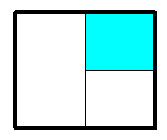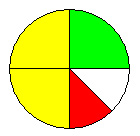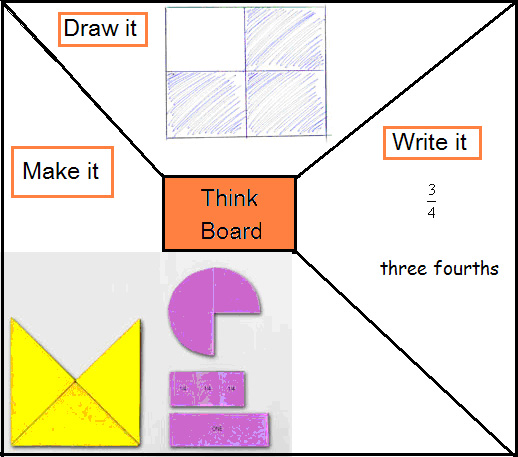Early Fraction Ideas with Models: 2.5 - Part 2
Teaching Strategies
The various models for representing fractions can be categorised in the following way:
- discrete models (individual objects such as counters and pencils) and
- continuous models (based on relative area or relative length).
The activities below focus on continuous models, as students can experience additional difficulty with discrete models. Area models (circles and squares) are useful, but it is important that students move on to linear models such as fraction strips (as seen in a fraction wall). Fraction strips are based on relative length and are an important pre-cursor to placing fractions on the number-line which is required at Level 4.
It is important to use language that will assist students to develop early fraction ideas. For example, rather than saying “1 over 3” or “1 on 3” (which describes the symbol only) it is more meaningful for students at this level if we talk about “one third” and the whole that it comes from; for example “one third of the square is shaded red”. Students will need to be familiar with both the words quarters and fourths, as they will encounter both in various situations.
For more information, see:
Activity 1: What is the same and what is different? emphasises that it is the relative size (with respect to the whole/one) that determines the fraction.
Activity 2: What fraction is this? continues the focus on relative size by providing diagrams that can generate various fractions.
Activity 3: Folding paper strips into halves, quarters and eighths and
Activity 4: Folding paper strips into thirds and sixths encourage active folding/partitioning of a linear model to create equivalent fractions.
Activity 5: Consolidating links between representations with a think board provides an opportunity for students to link words, symbols, materials and drawings.
Activity 6: Making the whole or one is a ‘reverse’ activity as students need to create the whole/one given a certain fraction.
Activity 7: Skip counting by fractions provides practice renaming as well as appreciating how numbers that involve fractions fit between other numbers (ie 2 1/4 is between 2 and 3).
Activity 1: What is the same and what is different?

“What is the same and what is different?” is a useful question in many mathematical situations. The aim of this activity is to focus attention on the central idea of relative sizes, which is the key idea for fractions, not other distracting features of the models that we use.
Provide students with various diagrams of the sort used for teaching fractions. There are some examples above. Ask students to choose any pair of diagrams, and discuss ‘what is the same and what is different’. For example, a student may choose H and I, and comment that the whole shapes are the same size, and the shaded parts are the same size, and the same fractions is shaded (a half), but one has the left half shaded and the other has the top half shaded. Another student might choose H and G, and note the sizes are different, but both have a half shaded. A student might choose C and K and note that they both have 2 parts shaded, but they have different fractions shaded.
You might choose to represent 1/2 and 1/3 using a variety of shapes (e.g. squares, circles, strips and triangles). Include some shapes which are clearly larger than others (e.g. large squares and small squares) with 1/2 of each shaded. Include different arrangements of shaded portions to bring out the misunderstandings discussed in Illustration 1 above.
The discussion should focus students’ attention on the fact that a fraction is result of comparing 2 things; it is a relative amount of shading not an absolute amount. For example, the area (amount of shading) of 1/2 of the small square might be clearly less than the shading of 1/2 of the large circle. So the shaded portions are different if we are discussing their absolute sizes. On the other hand, if we are comparing the relative sizes of the shaded part to the whole (that it comes from), then the amount of shading is the same, (both 1/2).
Activity 2: What fractions can you see?
Provide students with the diagram below. Ask them to write down as many fractions as they can ‘see’, and then ask them to explain their answers.

Students might (correctly) say:
- Blue is ¼ of whole square
- White is ¾ of whole square
- Blue is 1/3 of white
Note that it is incorrect to say that the blue is 1/3 of the whole square. Students with this wrong idea might explain that the square was divided into 3 parts and 1 of these 3 is now coloured blue.

Students might (correctly) say:
- Red is 1/8 of whole circle
- White is 1/8 of whole circle
- Yellow is 1/2 of whole circle
- Green is 1/4 of whole circle
- Red is 1/2 of green
- Red is 1/4 of yellow
- Green is 1/2 of yellow
Note that it is incorrect to say that the red is 1/5 of the whole circle. Students with this wrong idea might explain that the circle was divided into 5 parts and 1 of these 5 is now coloured red.
The diagrams above have been chosen because they both demonstrate a common student error. The first diagram was drawn when a student was asked to shade 1/3 of the square and proceeded to bisect (halve) first, then halve one part again. The second diagram was drawn when the task was to draw 1/5 of the circle. The student bisected to make 2 parts, bisected both to make 4 parts, and bisected one of them to make 5 parts. Bisecting is a very natural action for humans and it produces halves, quarters, eights etc. It requires little teaching. However, teachers need to explicitly teach strategies to divide into thirds, fifths etc.
Activity 3: Folding paper strips into halves, quarters and eighths
Students need 3 long strips of white paper of equal length for folding (e.g. slice A3 paper into long strips). An extra strip of the same length, but a different colour and not folded, is to be used as a reference ‘one’ and kept on hand for the students to see. Guide students through folding the strips and discuss ‘renaming fractions’ to link with their previous experiences of renaming whole numbers. Also introduce the more common phrase “equivalent fractions”. Use some of the strips to make a poster or wall display for future reference; marking the fold lines with texta if necessary. This is the start of a ‘fraction wall’, but the process of folding is just as important as the final product.

Step 1: Instructions for halves and quarters
- Take a strip and fold it so it is half as long as the blue strip I am holding. Hold it up to show me.
- Now take another strip and fold into halves and then fold your halves in half.
- Open up and check there are 3 fold lines and 4 parts.
- Now show me a strip which is 1 quarter of the length of the blue strip.
- Show me a strip which is 2 quarters of the length of the blue strip.
- Now show me a strip which is 3 quarters of the length of the blue strip.
- Show me a strip which is 4 quarters of the length of the blue strip.
Questions to ask students:
- Before you open up your strip, how many fold lines do you think you will see?
- How many parts do you think you will see when you open?
- Have we made a strip this long before? If so, what did we call it?
After this we can:
- write: 2/4 = 1/2 and say “2 quarters is equal to a half”
- say “2 quarters is the same as 1 half”
- say “2 quarters and 1 half are equivalent fractions”
- say “we have renamed 2/4 as 1/2 ”
Step 2: Extend to eighths
- Take a new strip of paper and fold it into quarters. Hold it up to show me.
- Now fold your quarters in half.
- Open up and check there are 7 fold lines and 8 parts.
- Now show me a strip which is 1 eighth of the length of the blue strip.
- Show me a strip which is 2 eighths of the length of the blue strip, etc.
Questions to ask students:
- Before you open up your strip, how many fold lines do you think you will see?
- How many parts do you think you will see when you open?
- [Keep asking: Have we made a strip this long before? If so, what did we call it?]
Step 3: Practice renaming and ordering
Write a list of fractions on the board that represent the lengths of the strips they folded (relative to the blue strip - the whole/one).
1/2 2/2 1/4 2/4 3/4 4/4 1/8 2/8 3/8 4/8 5/8 6/8 7/8 8/8
Ask students to choose a fraction that they can rename (eg. 4/4 could be renamed as 1, 6/8 as 3/4, etc). Students now group the fractions on the list into groups with the same value (ie equivalent).
Now choose a fraction (e.g. 3/4) and ask students to find a fraction from the list which is smaller than it. As well as the obvious answers (e.g. 1/4 and 2/4) encourage students to choose fractions with different denominators (e.g. 1/8 and 1/2).
Now choose a different fraction and ask students to choose a fraction from the list that is larger than it.
Finally put the fractions in order.
Activity 4: Folding paper strips into thirds and sixths
This follows on from Activity 3; students need 2 more white strips (one for thirds and one for sixths) and you need to hold the same blue strip to represent the whole/one.

Ask them to fold their white strips to show one third the length of the blue strip. Note that thirds cannot be formed by folding in half. Repeated halving leads to fractions with denominators of 2, 4, 8, 16, 32 … but not 3, 5 etc. You may need to suggest that students fold the strip into an S-bend and then adjust. (This is a useful technique for other fractions such as fifths).
Sixths can then be made by halving thirds. As in Activity 3, discuss renaming and then ordering and grouping fractions.
Activity 5: Consolidating links between representations with a think board
Use a ‘think board’ with three sectors:
- Make it
- Draw it
- Write it
Vary the components that you provide, and encourage students to use several materials and drawings to make connections between these alternatives.

On the think board above, the whole/one is obvious for the circle and square. For the fraction strips, however, the whole/one needs to be included as otherwise there is no clear reference.
Include numbers which are larger than one (e.g. 1 1/2, 2 1/4, 4 2/3, etc.).
Activity 6: Making the whole (or ‘Making one’)
In this ‘reverse’ activity, the focus is on building the whole/one from the given fraction in contrast with most activities where a fraction is created from the given whole/one.
Hold up a strip of ribbon, and say “If this is 1 half of a ribbon, how long is the whole ribbon?” Students can indicate approximate size with their hands, or draw it on the board. They might use the ribbon to help mark out the line on the board. Ask them to explain their answer.
Use the same strip and repeat with many other fractions:
- “If this is 1 third of the ribbon, what is 2 thirds of the ribbon?”
- “If this is 1 third of the ribbon, what is 1 ribbon?”
- “If this is 1 third of the ribbon, what is 5 thirds of the ribbon?”
- “If this is 1 sixth of the ribbon, what is 2 sixths of the ribbon, 3 sixths of the ribbon, 4 sixths of the ribbon, 5 sixths of the ribbon, 6 sixths of the ribbon, 7 sixths of the ribbon, …?
- “If this is enough to make 3 ribbons, how long is 1 ribbon?”
- “If this is enough to make 3 ribbons, how long are1½ ribbons?”
- “If this is enough to make 3 ribbons, how long is 1 ribbon?”
- “If this is enough to make 1½ ribbons, how long is 1 ribbon?”
- “If this is 1 third of a ribbon, what is1 sixth of the ribbon, 1 ninth of the ribbon, ..?”
These sorts of explanations might occur:
- What is 1 third of the ribbon? It is a portion that, when 3 of them are put together, they make one whole ribbon.
- What is 1 fifth of the ribbon? It is a portion that, when 5 of them are put together, they make one whole ribbon.
- What is 2 sixths of the ribbon? It is 2 of the portions that we call 1 sixth of the ribbon. So, if we cut it into 2, then 6 of them make one whole ribbon.
- What is 5 sixths of the ribbon? It is 5 of the portions that we call 1 sixth . So, if we cut it into 5 pieces, then 6 of these make one whole ribbon.
Activity 7: Skip counting by fractions
This activity provides practice skip counting by fractions. Skip counting is an early form of addition (2 fourths and 1 fourth is 3 fourths) which lays the foundation for understanding later symbolic manipulations ( 2/4 + 1/4 = 3/4 ).
Provide students with a sequence to continue:
eg. 1/4, 2/4, 3/4, 4/4, 5/4, 6/4, __, ___, ___, ___. or 1/4, 2/4, 3/4, 1, 1 1/4, 1 2/4, 1 3/4, 2 1/4, 2 2/4, 2 3/4 __,
Extensions:
As well as continuing the sequence, ask them to skip count to make a sequence such as the one underneath, where some fractions are renamed
e.g. 1/4, 1/2, 3/4, 1, 1 1/4, 1 1/2, 1 3/4, 2, 2 1/4, 2 1/2, 2 3/4, 3, etc.
Then play games (like Buzz) where students need to give the next number in the sequence.
Further Resources
The following resource contains sections that may be useful when designing learning experiences:
Digilearn object *
Fraction fiddle: comparing non-unit fractions – a kookaburra and a magpie each gobble up part of a worm. Students identify which bird ate the most. For example, decide whether three-quarters (3/4) is larger than two-thirds (2/3). Students build the fraction that each bird ate. Students compare the fractions on a number line. Students check which fraction is bigger.
(https://www.eduweb.vic.gov.au/dlr/_layouts/dlr/Details.aspx?ID=4270)
Fraction fiddle: matching cake fractions – students fill orders in a cake shop. Students match a fraction to parts of a cake. For example, identify the fraction of a cake remaining after it has had one quarter removed. Students check their prediction by making the fraction and seeing what it looks like as part of a circle. Students watch the circle change as they adjust the numerals in the numerator and denominator of the fraction.
(https://www.eduweb.vic.gov.au/dlr/_layouts/dlr/Details.aspx?ID=4272)
Cassowary fractions – students help a park ranger to arrange fencing in a wildlife sanctuary. Students divide common geometric shapes into equal-sized sections for keeping cassowaries. Students group the enclosures to form a quarantine zone for sick or injured birds. Students then express the divisions of the enclosures as fractions.
(https://www.eduweb.vic.gov.au/dlr/_layouts/dlr/Details.aspx?ID=4603)
Design a park – students help Terry the town planner to design a site plan for a park. Students assign regions on a grid for different uses, eg picnic, swings, sandpit, pond. Students use this tool to explore how to express fractions and display them in different ways. Students select boxes within the grid and view or enter corresponding fractions and their equivalents. Students interact with a dynamic number line to express fractions in different ways.
(https://www.eduweb.vic.gov.au/dlr/_layouts/dlr/Details.aspx?ID=4779)
* Note that Digilearn is a secure site; SMART::tests login required.
Indicator of Progress
For Early Fraction Ideas with Models indicators of progress, see: Part 1
